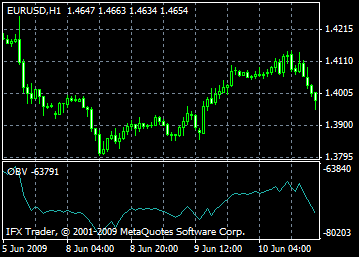Technical Indicator Balance Volume (OBV) is a momentum technical indicator that relates volume to price change. This indicator was introduced by Joseph Granville, OBV is considered to be a pretty simple indicator. If the closing price of the current bar is higher than the previous closing price, volume of the current bar is added to the previous volume of OBV; if the closing price of the current bar is lower than the previous closing price, current volume is deducted from the previous volume of the balance.
On Balance Volume analysis is based on the principle that OBV changes precede price changes. According to this principle balance volume rising indicates that professionals invest into the instrument. When later wide audience invests funds, On Balance Volume starts rapid growth.
If the price precedes OBV movement, a "non-confirmation" has occurred. Non-confirmations can occur at the bull market tops (when the price rises without the OBV growth or precedes it) or in the bottom of the bear market (when the price starts falling and the On Balance Volume does not decrease or precedes it).
The OBV is in a rising trend when each new peak is higher than the previous one and each new trough is lower than the previous trough. The same way, OBV falling trend is supposed successive decrease of peaks and troughs. When the OBV is moving sideways and is not making successive highs and lows, it is an indicator that a trend is not defined.
If a trend stops it will remain in the same position until the break takes place. The trend break may happen in two cases: when the trend changes from a rising trend to a falling trend or on the contrary: from a falling trend to a rising trend.
In second case the OBV becomes undecided and remains undecided for more than 3 periods. Thus, if uptrend changes to an undecided one and remains undecided for only two days and then changing back to uptrend, On Balance Volume is considered to be an uptrend for all this period.
When the OBV trend changes its direction to a rising or falling trend, a "breakout" occurs. The OBV breakouts usually warn about a price break and investors should hold long positions if the OBV makes a break upwards and sell in case the BVI breaks downwards. Open positions should be held until the trend changes.

Calculation
If today`s close is greater than yesterday`s close then: OBV(i) = OBV(i-1)+VOLUME(i)
If today`s close is less than yesterday`s close then: OBV(i) = OBV(i-1)-VOLUME(i)
If today`s close is equal to yesterday`s close then: OBV(i) = OBV(i-1)
Where:
OBV(i) - is the indicator value of the current period;
OBV(i-1) - is the indicator value of the previous period;
VOLUME(i) - is the volume of the current bar.

The InstaForex Analyst Team
GK InstaFintech © 2007-2025
















